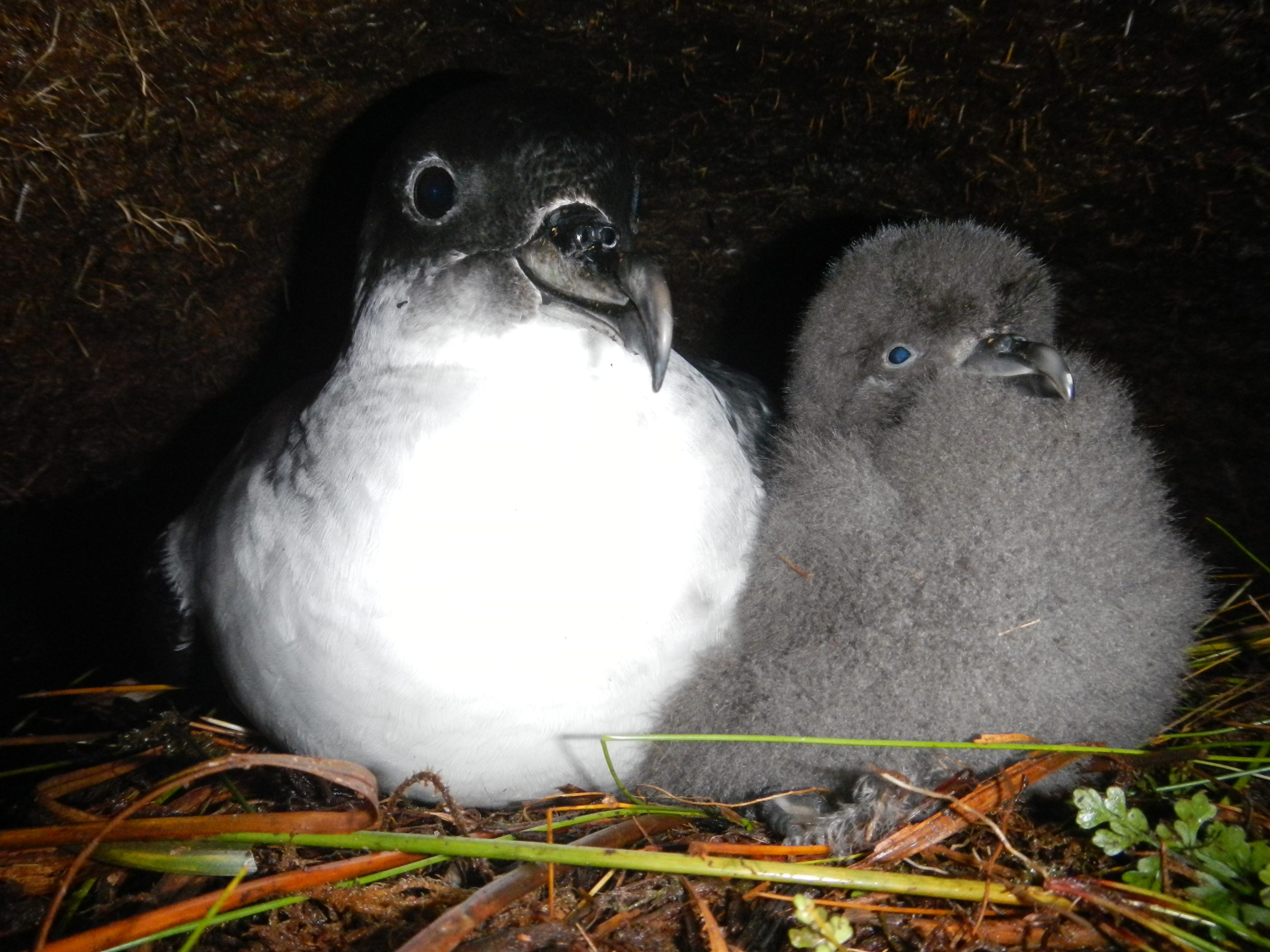Grey Petrel at sea, watercolour by ABUN artist Walt Anderson for ACAP; after a photograph by Hadoram Shirihai
Note: The illustrated Species Summaries have been written to help inform the general public, including school learners, of the biology and conservation needs of the 31 ACAP-listed species. They serve to complement the more detailed and referenced ACAP Species Assessments. To date, summaries for the 22 species of albatrosses have been produced in in all three ACAP official languages, English, French and Spanish.
Texts have also been prepared for the nine ACAP-listed petrels and shearwaters in English, but as yet have not been translated into French and Spanish. As an interim service, the illustrated English texts are being posted to ACAP Latest News, continuing here with the Grey Petrel Procellaria cinerea.

A Grey Petrel alongside its chick in their burrow on Marion Island, photograph by Ben Dilley
The Grey Petrel is one of five medium-to-large petrels within the genus Procellaria, along with the Black, Spectacled, Westland and White-chinned. Among all the petrels and shearwaters in the family Procellariidae, they are the largest that dig and breed in burrows. An ash-grey petrel with a white belly and darker underwings and tail, noticeably paler than the dark brown or black of the other species in the genus. The bill is pale yellow with a black upper line.
The Grey Petrel has a circumpolar distribution in the Southern Ocean. It breeds on sub-Antarctic and sub-tropical islands belonging to Australia, France, New Zealand, South Africa and the United Kingdom in the South Atlantic (Gough and Tristan da Cunha), southern Indian (Amsterdam, Crozets, Kerguelen and Prince Edwards) and southern Pacific (Antipodes, Campbell, Macquarie). Grey Petrels from Antipodes migrate to South American Pacific waters after breeding.
Population numbers, as for many burrowing petrels, are not well known; a rough global estimate is of 80 000 breeding pairs. The largest population of an estimated 50 000 pairs (in 2001) is found on New Zealand’s Antipodes Island. Amsterdam (which likely once had a large population), Campbell, Macquarie and Tristan da Cunha support less than 100 breeding pars each. The other islands have estimated populations in the low thousands of pairs. Population trends, although not known overall, vary between islands; the species is thought to be decreasing in numbers at Gough and Kerguelen, and recovering from a low base on Campbell and Macquarie. The species breeds annually in loose colonies, laying a single egg and rearing the chick in burrows during the austral winter. Diet of the Grey Petrel is primarily squid along with fish caught by surface seizing or shallow diving, augmented by scavenging behind fishing vessels.
Although the Grey Petrel has been categorized as only globally Near Threatened, it faces ongoing threats both at sea and on land. It is at risk (with a bias to females) of being caught by commercial longline fishing vessels, notably in Australian and New Zealand waters and around the French Kerguelen Islands. On Gough Island and on Marion Island (Prince Edwards) introduced House Mice prey upon downy chicks in winter when other food resources are scarce, causing low breeding success. On the plus side all introduced mammals have been removed from Antipodes, Campbell and Macquarie. Eradication attempts to rid Gough and Marion of House Mice are currently due in 2021 and 2013, respectively.
The Grey Petrel is listed both within the Albatross and Petrel Agreement (ACAP) and the Convention on Migratory Species on Appendix II. All breeding islands are national nature reserves with management plans or equivalents, restricting landings by permit only. All but South Africa’s Prince Edward Islands are World Heritage Natural Sites and several are also Ramsar Wetlands of International Importance. Most are surrounded by Marine Protected Areas of varying sizes.
Sources:
ACAP 2012. Grey Petrel Procellaria cinerea.
Bell, E.A. 2018. Grey petrel. In: Miskelly, C.M. (Ed.) New Zealand Birds Online.
BirdLife International 2021. Species factsheet: Procellaria cinerea.
John Cooper, ACAP Information Officer, 21 March 2022

 Español
Español  English
English  Français
Français 